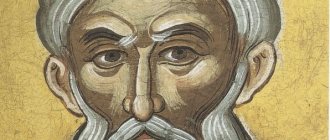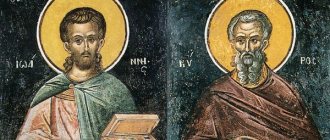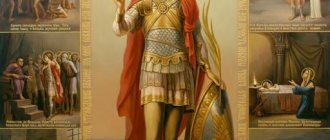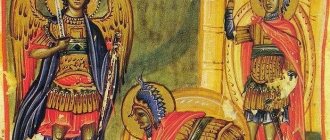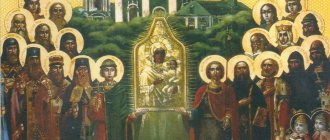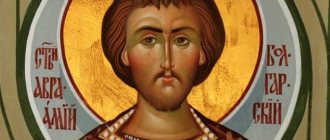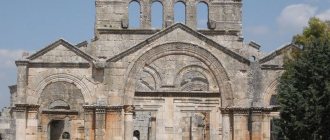Brief biography
The life of a Christian warrior was short. He believed in the Lord at the turn of the 3rd-4th centuries, during the reign of the Roman emperor Decius. Decius was known for his intolerance of Orthodox symbols and was known as an ardent persecutor of Christians. During the period of his reign, several attempts were made to completely destroy entire settlements where people who had abandoned paganism lived. The emperor sent soldiers who set fire to villages and executed Christians.
Origin
Researchers are still arguing about who Christopher was. There are several versions of its origin:
- came from a Roman tribe, bore the name Reprev;
- was a member of the Cynocephali tribe, a barbarian tribe where people with modified appearance were born;
- born in Rome, was the son of one of the legionnaires;
- According to one version, Reprev was born on the territory of the Roman Empire, was handsome and strong, and began to serve the emperor thanks to his military qualities.
Preaching the Word of God
Sources claim that Reprev came to Christ long before his own baptism. His faith was deep, based on true respect for the fundamental laws of Orthodoxy. He preached God's Word, which became known to the emperor, a champion of Christianity. The emperor ordered the warrior to be arrested and brought to the palace for clarification. Christopher accepted the arrest with humility and went to the palace.
On the way, he read sermons, after which some soldiers accepted his faith. They were impressed by divine miracles:
- Christopher's words and prayers made the wooden staff that was in his hands bloom;
- Thanks to his prayers, there was an increase in bread on the tables, which was not enough for the soldiers who arrested him.
Death of Callinice and Aquilina
Reprev appeared before the emperor with Christian humility. Despite this, Decius was frightened by his menacing appearance. According to many legends, Christopher was tall and endowed with strength. The emperor fainted, but after he came to his senses, he decided to break the faith of the formidable Christian by deception. Decius sent harlots and two women, Kalinnikia and Aquilina, to the resting warrior. They came to Reprev under the cover of darkness and tried to seduce him, thereby forcing him to sinful pleasures.
Christopher addressed the women with a sermon, and after some time they switched to the Christian faith. The emperor was indignant when he learned about this.
Aquilina was hung by her hair and a heavy stone was tied to her feet. She died in excruciating suffering the next day. Callinicia said that she wanted to become a pagan again and asked to be taken to a pagan temple, to the statue of Zeus. There she tied her belt to the torso of the pagan god and knocked him over. The woman also managed to knock over the statues of Apollo and Hercules before she was grabbed by the emperor's servants. Decius ordered to pierce Callinicia's body with a spear. She died praying to Jesus Christ. Since then, Callinice and Aquilina have been mentioned as martyrs who came to faith through repentance of sins.
Torment
After the death of the harlots, there followed the executions of the pagan soldiers who were converted to the faith by Christopher. The emperor then ordered the warrior to be executed. His torment was terrible. First, Christopher was put in an iron box, which was suspended over a large fire. According to the emperor's plan, the saint was supposed to burn in agony, but he did not feel pain and read sermons. The pagans gathered around the fire and admired the faith of the martyr.
After this torture, the emperor ordered the warrior to be thrown to the bottom of a deep well, tying a heavy stone to his feet. After some time, an angel carried him out of the well. The torment took place against the backdrop of a pagan holiday, and the attention of most residents of the city was attracted to it. The emperor ordered Christopher to be beheaded to prevent popular uprisings.
Story
According to Eastern tradition, this saint lived in the third century and his name was Reprev. He came from the region of Marmarik, in the Libyan Desert. In one of the battles he was captured by Roman soldiers. After this, he served with the Romans in a special unit consisting only of Berbers. This man was of enormous stature and terrifying behavior, he was cynocephalous (with a dog's head), like all representatives of his tribe.
According to another legend that appeared in Cyprus, the saint was very handsome. Wanting to avoid temptations and women who bothered him, Christopher prayed to God, who, in response to this prayer, replaced his head with a dog’s.
The first option is, of course, more likely. Apparently, he was very scary, which is why they associated him with a dog.
Like most saints of that time, Christopher preached successfully, for which he paid with his life. The emperor ordered the martyr to be thrown into a red-hot copper box. However, the saint did not experience suffering and remained unharmed. After many cruel tortures, the martyr's head was finally cut off with a sword.
Meaning in Orthodoxy
Pseglavets Christopher is recognized by the Orthodox Church as a holy martyr. His unwavering faith and devotion to Jesus Christ is beyond doubt among historians. Figures such as Christopher are always highly valued and revered by the Orthodox Church. This is an example of unbending fortitude, supported by indestructible faith.
The name “Christopher” arose as the phrase “bearer of Christ.” Its occurrence is explained in several versions. According to one of them, the warrior was the same giant who carried little Jesus on his shoulders through a seething mountain stream. In this case, the name has a literal meaning. According to another common version, the carrying of Christ in the heart was recognized by the warrior during torture and torment, when even the most devoted pagans saw the strength with which the martyr believed in God.
Crucifixion of Christ
The above list would be incomplete if it did not mention the Crucifixion of Christ. Christ is the Savior of all mankind. When praying to the saints, you should understand that they help not with their own power, but with the power given to them from above by Jesus Christ. Prayer to Jesus Christ before traveling:
Lord Jesus Christ, our God, the true and living way! You accompanied Your imaginary father Joseph and Your most pure Mother the Virgin Mary to Egypt, and also accompanied Luke and Cleopas to Emmaus! Now we humbly pray to You, Most Holy Master, to accompany us, Your servants, with Your grace. As to Your servant Tobiah, send a Guardian Angel and mentor, preserving and delivering us from every accident, from visible and invisible enemies and instructing us to fulfill Your commandments, accompanying us in prosperity and health on the journey and returning home safe. Help us to fulfill all our good intentions for Your glory. For it is Your nature to have mercy and save us, and to You we exalt glory with Your beginningless Father and the Most Holy and Good and Life-giving Spirit forever. Amen.
The iconography and mystery of the dog's head
Until the middle of the last century, Christopher was depicted on icons with a dog's head. The most ancient icons date back to the 5th-6th centuries. Ceramic images of a warrior with a dog's head became the prototype of later iconographic images. This feature is explained in different ways:
- According to one version, Christopher's nickname was misinterpreted by church sources: the area of Cynoscephalia marked the beginning of the legend about the presence of a dog's head, while other researchers claim that it was about the region of the Roman Empire, Thephalia.
- There is a version that the description of the terrible, frightening appearance could have been taken literally by the icon painters of antiquity.
- One option is to interpret fidelity and unwavering adherence to Christ as dog fidelity, because these animals are known for their unique devotion.
- The origin of Christopher in some sources is described as the birth among people of a tribe with dog heads, of which there were many mentions in descriptions of ancient times.
- According to one version, Christopher had an attractive appearance from birth, for which he was loved by women. Appearance bothered Christopher, so he prayed to change it.
Christopher was depicted as a dog-head until the beginning of the 17th century, then the Synod imposed a ban on such images, which confused many parishioners.
Since the 18th century, Saint Christopher has been depicted on icons in two ways:
- like a beautiful long-haired young man with a cross in his hands, having 4 ends;
- like a giant who carries the Baby Jesus on his shoulder, thereby helping him cross a wide, deep river.
Icons on which Christopher depicts a dog’s head have been preserved in Old Believer monasteries and churches. A statue of the dog-headed martyr saint is also kept on the grounds of Notre Dame Cathedral in France.
Content
- 1 Life 1.1 Life in the Eastern tradition
- 1.2 Life in the Western tradition 1.2.1 Literary treatment
- 1.2.2 Criticism of historical accuracy
- 3.1 Iconography in Orthodoxy 3.1.1 The ban on the “dog head”
- 4.1 In Spain
Day of celebration and veneration of the martyr
The Catholic Church has established the celebration and veneration of St. Christopher as the day of May 9th. The saint is especially revered by residents of the European part of the continent. He is called the protector of travelers, which is why you can often see medallions or magnets with the image of the saint sold in souvenir shops. He also patronizes sailors, taxi drivers, and drivers.
Christopher is the patron saint of Lithuania, his image is included in the main coat of arms of the city of Vilnius. On the territory of this city, schools are named after him, as well as the main brass band. The statuette of Saint Christopher is a reward for services to the residents of Vilnius. Its award ceremony takes place every year on the eve of Christmas.
A temple was built in Cuba named after the holy martyr. Residents of Havana go to Christopher for consolation and strengthening of faith.
The Egyptian monastery, built according to the plans of an unknown architect, is dilapidated, but is still able to shelter several nuns. Spain is one of the countries where Christopher is known as the patron saint of sailors. Amulets with the image of St. Christopher are sold here, and small churches named after him have been opened. The Spaniards believe that the amulet, consecrated in the temple, protects travelers at sea from storms and unexpected sea traps.
Relics
There is written evidence of Archdeacon Pavel of Aleppo, who, while in Moscow in the second half of the 17th century, participated in the “rite of washing the relics.” Listing the various relics of the Annunciation Cathedral, he described the head of St. Christopher being kissed by a dog[5][6]:
Here are the names of the relics of those saints that we could remember: <...> the head of the martyr Christopher with a face exactly like a dog, with a long mouth; it is hard as flint - our mind was struck with amazement: there is no room for doubt!
According to Catholic tradition, the head of the saint, kept for some time in Constantinople, was then transported to the island of Rab in Croatia. When the Normans invaded the island and besieged the city of Rab in 1075, the townspeople placed Christopher's relics on the walls. Miraculously, the wind changed and the enemy ships were blown away from the island. One of the large medieval fortresses in Rab is named after the saint[7][8].
Today, a gilded reliquary with the skull of St. Christopher is kept in the Museum of Sacred Art in the Church of St. Justina of Rab in Croatia[9][10][11][12].
What do they ask the saint for?
Saint Christopher is asked for protection. It is often addressed in front of the home iconostasis. At the same time, when offering a prayer, it is not necessary to have an image of a saint before your eyes; it is enough to focus on his appearance, remember his merits, and think about the strength of his faith.
They pray to a Christian warrior for various reasons:
- because of his unusual appearance, people with physical disabilities and suffering from various ailments turn to him;
- travelers and drivers ask for protection on the roads while traveling;
- believers ask to strengthen their faith, to help find a way out of a difficult situation;
- Many Orthodox Christians turn to the martyr when they want to protect themselves or their loved ones from temptations and ask to be shown the true path.
It is believed that the saint helps to heal contagious diseases and relieve toothaches.
Prayer text
O glorious and victorious martyr of Christ Christopher, true warrior of the holy Church, praise and adornment to your earthly relatives. You, not being afraid of godless persecution, you confessed the Orthodox faith even to the point of blood, and through your suffering you gave an image to the faithful, you entered the Kingdom of Heaven through the gates of righteousness. We also pray to you, just as you once gained the strength to endure suffering through your prayer to the Lord, so now we pray that the Lord will give us the strength to keep His life-giving commandments, and may He deliver us from the bonds of sin and atheism, and may our Fatherland remain in Orthodoxy until the end century. Amen.
Image of the Mother of God "Hodegetria"
This type of Eastern Orthodox icon of the Mother of God, called the "Guide" or "Showing the Way", is an ideal choice for drivers and travelers. The image is an iconographic image of the Ever-Virgin holding the Son Jesus Christ in her arms. At the same time, the Mother of God points to the Baby as the savior of humanity.
Any of the famous icons of the Mother of God (Blachernae, Voroninskaya, Tikhvinskaya, Smolenskaya and others) will show the traveler the right path and help avoid danger. Text of the prayer:
Emotion Board: Creative Ways to Develop Humanity in Children
“Pink bunnies” for tea, or How to make a cute and delicious cake
Barbie: how dolls with unrealistic body proportions affect the psyche of girls
Oh, my Most Holy Lady, Virgin Mary, Hodegetria, Patroness and hope of my salvation! Behold, on the journey that lies before me, I now want to leave and for the time being I entrust to You, my most merciful Mother, my soul and body, all my mental and material powers, I entrust myself entirely to Your strong gaze and Your all-powerful help. Oh, my good companion and protector! I earnestly pray to Thee, that this path may not creep, guide me on it and direct it, All-Holy Hodegetria, as She herself, to the glory of Thy Son, my Lord Jesus Christ, be my helper in everything, especially in this distant and difficult While traveling, protect me under Your sovereign protection from all troubles and sorrows that may arise, from enemies visible and invisible, and pray for me. My lady! May Your Son, Christ our God, come to help me, His peaceful, faithful mentor and guardian Angel, and just as in ancient times He gave food to His servant Tobiah Raphael, in every place and at all times, keeping him on the road from all evil, so is mine guide the path safely and protect me with heavenly power. May she return me to health, peace and completeness to my dwelling for the glory of Your Holy Name, glorifying and blessing Him all the days of my life and magnifying You, now and ever, and to the ages of ages. Amen.

